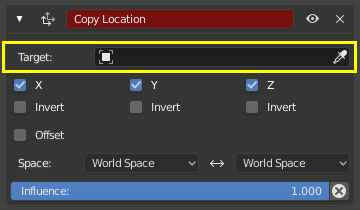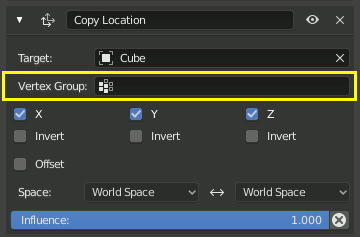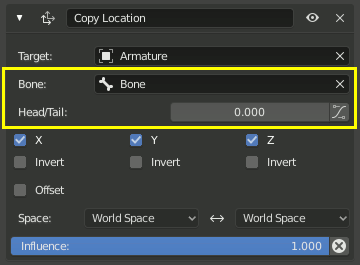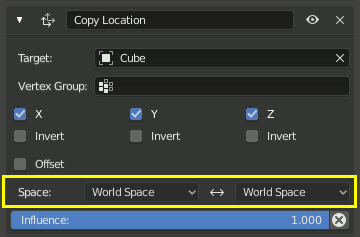Common¶
대상(Target)¶
대상 데이터 ID(data ID) 필드를 사용하여 constraint를 선택한 대상 오브젝트에 연결할 수 있습니다. 이 링크는 constraint가 작동할 수 있도록 데이터를 제공합니다. 예를 들어 복사 위치 Constraint을 사용하려면 위치 데이터가 필요합니다. 대상 필드를 입력하면 위치 복사 constraint가 대상 오브젝트의 위치 데이터를 사용하기 시작합니다.

The Target field must be filled in for the constraint to function.¶
기본적으로 대상은 Object Origin 을 대상 포인트로 사용합니다.
대상 필드가 Mesh 또는 Lattice 오브젝트에 연결되면 Vertex Group 필드가 나타납니다. 버텍스 그룹의 이름을 입력하면 constraint가 개체의 원점 대신 이 버텍스 그룹의 중앙값을 대상으로 지정된다.

대상 필드가 Armature 에 연결되면 Head/Tail 슬라이더와 함께 Bone 필드가 나타납니다. 본의 이름을 입력하면 constraint가 전체 아마튜어 오브젝트 오리진 대신 본을 지정합니다.

슬라이더는 본의 Head 와 Tail 사이에서 대상의 정밀하게 위치를 이동합니다. 일부 constraint에는 Bendy Bones 의 곡선 형태를 사용할 수 있는 슬라이더 옆에 버튼이 있습니다.
공간¶
Constraints가 작동하려면 기준 프레임이 필요합니다. 이 기준 프레임을 constraint의 《공간》이라고 합니다. 한 공간을 다른 공간과 비교하여 선택하면 이 기준 프레임이 변경되고 constraint의 동작이 크게 변경됩니다.
공간을 변경하면 constraint의 동작이 어떻게 변경되는지 이해하려면 두 개의 빈 공간을 사용하여 실험하는 것이 좋습니다. 비어 있는 각 축의 로컬 축을 볼 수 있도록 화살표로 표시해야 합니다. 서로 바로 위에 있더라도 항상 둘 다 보이도록 다른 것보다 약간 큰 크기의 빈 공간을 확보해야 합니다. 다음 다른 대상을 대상으로 하는 비어 있는 하나에 constraint을 추가하고 여러 가지 방법으로 대상을 이동, 회전 및 확장하여 철저하게 실험합니다.

This constraint is set to use World Space as the frame of reference for both its Target Space and its Owner Space.¶
대상 공간과 소유자 공간을 지정¶
Constraint의 대상을 평가하는 데 사용되는 공간을 대상 공간이라고 합니다. Constraint가 있는 오브젝트(constraint을 소유하는 오브젝트)를 평가하는 데 사용되는 공간을 소유자 공간이라고 합니다. 공간 선택 메뉴 위에 마우스를 올려 놓으면 대상의 공간 또는 소유자의 공간에 영향을 미치는지 여부를 알 수 있습니다.
When the constraints use a Target and/or/nor an Owner space there will be no, one or two selector(s). The Copy Location constraint in example use both Target and Owner space.
Constraint가 대상 공간과 소유자 공간을 모두 사용하는 경우 대상과 소유자는 공간 유형의 조합일 수 있습니다.
공간 유형¶
- 월드 스페이스
이 공간 유형에서 월드는 오브젝트(또는 본)에 대한 기준 프레임입니다. 위치는 세계 원점에 상대적입니다. 회전 및 축척은 월드 축을 지향합니다. constraint 스택의 상위 항목인 오브젝트, 오브젝트의 상위 항목 및 기타 constraint에 대한 변환이 모두 고려됩니다.
- 로컬 공간
This space excludes all effects of the parent objects or bones, as well as the rest position and orientation of the bone itself. Only transformations applied to the object or bone itself are taken into account.
- 부모를 포함한 로컬(본만 해당)
The bone position and orientation is evaluated relative to its rest pose location and orientation, thus including both its own transformations and those caused by a possible parent relationship (i.e. the chain’s transformations above the bone).
- Pose 공간(본만 해당)
The bone position and orientation is evaluated in the armature object local space (i.e. independently from the armature transformations in Object Mode). Hence, if the armature object has null transformations, Pose Space will have the same effect as World Space.
- Custom Space
The position and orientation is evaluated relative to the current position and orientation of an arbitrary object or bone that is specified via additional input fields that appear when this option is selected. This can be used to evaluate the constraint using an arbitrary coordinate system.
영향¶
영향 슬라이더는 constraint가 제한된 오브젝트(대상)에 얼마나 영향을 미칠지 결정합니다.

영향값 0.0은 영향을 미치지 않습니다. 1.0은 영향이 전체 효과를 발휘합니다.
(0.0 ~ 1.0) 사이의 값은 부분적인 영향을 미치지만 조심하세요. 특히 constraint 스택이 복잡해지면서 이러한 부분 효과를 제어하기가 어려울 수 있습니다.
영향 값은 애니메이션이 가능하므로 constraint를 끄거나 필요에 따라 부분적으로 켤 수 있습니다.
영향 슬라이더 뒤의 X 버튼을 사용하여 현재 오브젝트 위치를 보존하는 동안 constraint을 비활성화할 수 있습니다. 다른 constraint이 활성 상태를 유지하는 경우 이 기능이 제대로 작동하지 않을 수 있습니다.